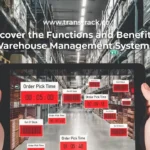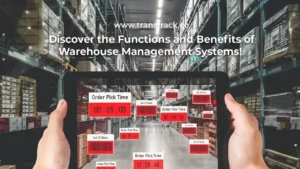Know the Functions and Types of Material Handling!
Posted on May 16, 2024 by Nur Wachda Mihmidati

Material handling is a process that involves managing, moving, storing, and controlling materials in various forms, including raw goods, semi-finished goods, and finished products within an industrial or commercial facility. The main purpose of this material is to increase efficiency and effectiveness in the production and distribution process, reduce operating costs, and improve work safety and comfort. Check out the full article with TransTRACK!
Material Handling Functions
Material handling has several important functions in various aspects of operations and management in industrial and commercial facilities. The following are the main functions of material handling, including some that you have already mentioned:
Save Work Time
- Operational Efficiency: By using the right tools and systems, material handling helps speed up the process of moving materials from one point to another, reducing the time required for manual operations.
- Automation: Automated systems such as conveyor belts, AGVs, and AS/RS can operate continuously without stopping, increasing productivity and time efficiency.
Structured Room Arrangement
- Space Optimization: Storage systems such as racking systems and AS/RS enable efficient use of vertical space, so that floor space can be utilized for other operations.
- Systematic Organization: With structured material organization, workers can easily find and access the materials they need, reducing search time and improving work efficiency.
Controlled Delivery
- Inventory Management: A good material handling system enables real-time inventory monitoring, so that deliveries can be better planned and executed.
- Tracking and Monitoring: With technologies such as barcodes and RFID, every material movement can be tracked and monitored, ensuring timely and accurate delivery.
Improving Work Safety
- Reduced Risk of Injury: The use of mechanized and automated equipment reduces the need for human labor to lift or move heavy loads, thereby reducing the risk of injury.
- Safer Working Environment: Well-designed equipment can improve operational safety by reducing the potential for accidents.
Reduced Operational Costs
- Labor Efficiency: By reducing the need for repetitive manual work, labor costs are reduced.
- Reduction of Material Damage: Proper material handling reduces the risk of damage during moving and storage, which can save on replacement or repair costs.
Improve Quality and Consistency
- Minimize Errors: Automated systems reduce human error in the material handling process, ensuring product consistency and quality.
- Controlled Process: Structured and controlled material handling processes help maintain product and service quality standards.
Supports Operational Flexibility
- Adaptation to Change: Advanced material handling systems can be easily changed or customized to accommodate changes in production or market demand.
- Scalability: Material handling equipment and systems can be scaled up according to evolving business needs, allowing capacity adjustments without major disruptions.
By performing these functions effectively, material handling contributes significantly to a company’s smooth operations, productivity and overall success.
Types of Material Handling Equipment
Material handling involves various types of equipment designed to move, store, and manage materials efficiently. The following are some types of material handling equipment along with a brief explanation of their functions:
Conveyors (Conveyor Belts)
- Function: Moving materials continuously along a predetermined path, typically used in production and packaging lines.
- Types: Belt conveyors, roller conveyors, chain conveyors, and gravity conveyors.
Forklift
- Function: Lifting and moving heavy or bulky materials, usually placed on pallets, within a warehouse or factory area.
- Types: Electric forklifts, diesel forklifts, LPG forklifts, and telehandler forklifts.
Racking and Shelving
- Function: Efficiently store materials in the warehouse, utilizing vertical space to optimize space usage.
- Types: Pallet rack, selective rack, drive-in rack, cantilever rack, and light shelving.
Hopper and Chute
- Function: To direct material, usually in the form of granules or powder, from one location to another by the force of gravity.
- Types: Stationary hoppers, wheeled hoppers, spiral chutes, and straight chutes.
Carts and Dolly
- Function: Moving goods or materials within a facility in a flexible and easy way, often used in light work.
- Types: Dolly platforms, hand trucks, utility carts, and rolling carts.
Storage and Retrieval Systems
- Function: An automated system that stores and retrieves materials with high precision, often used in automated warehouses and distribution centers.
- Types: Automated Storage and Retrieval Systems (AS/RS), carousels, and vertical lift modules (VLM).
Pallet Jacks
- Function: Easily lift and move pallets of materials within a warehouse or production area.
- Types: Manual pallet jacks, electric pallet jacks, and high lift pallet jacks.
Cranes and Hoists
- Function: Lifting and moving heavy or bulky materials vertically and horizontally in industrial areas.
- Types: Overhead cranes, gantry cranes, jib cranes, and electric hoists.
Automated Guided Vehicles (AGV)
- Function: An automated vehicle that moves materials without human intervention, typically used in an integrated production environment.
- Types: AGV forklift, towing AGV, and unit load AGV.
Robotic Arm
- Function: High-precision lifting, moving and placing of materials, often used in automated production processes.
- Types: Cartesian robots, SCARA robots, and articulated robots.
By using various types of material handling equipment, companies can manage materials more efficiently, safely, and economically, supporting smooth operations and increasing productivity.
Material handling is a crucial component of industrial and commercial operations that has a direct impact on efficiency, productivity and safety. By understanding and implementing various types of material handling equipment, such as conveyors, forklifts, shelving and racking, and automated storage systems, companies can optimize workflow and minimize operational costs.
However, effective material handling implementation requires careful planning and proper integration with a sophisticated logistics management system. This is where the important role of a Logistic Service Integrator, such as TransTRACK, becomes highly relevant.
TransTRACK provides integrated logistics solutions, ensuring that every aspect of material handling is managed with maximum efficiency.
To achieve more efficient and productive logistics operations, contact TransTRACK and discover how our Logistic Service Integrator solution can help optimize the material handling process in your company. With TransTRACK, transforming your material handling system to a higher level is easier and more efficient. Join the growing number of companies that are already enjoying the benefits of our integrated logistics solution.
Recent Post
Topic :
 Bahasa Indonesia
Bahasa Indonesia









